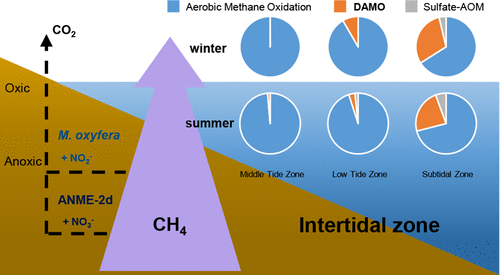当前位置:
X-MOL 学术
›
Environ. Sci. Technol.
›
论文详情
Our official English website, www.x-mol.net, welcomes your
feedback! (Note: you will need to create a separate account there.)
Denitrifying Anaerobic Methane Oxidation: A Previously Overlooked Methane Sink in Intertidal Zone
Environmental Science & Technology ( IF 10.8 ) Pub Date : 2018-12-17 , DOI: 10.1021/acs.est.8b05742 Jiaqi Wang 1 , Chaoyang Cai 1 , Yufen Li 1 , Miaolian Hua 1 , Junren Wang 1 , Hongrui Yang 1 , Ping Zheng 1 , Baolan Hu 1, 2
Environmental Science & Technology ( IF 10.8 ) Pub Date : 2018-12-17 , DOI: 10.1021/acs.est.8b05742 Jiaqi Wang 1 , Chaoyang Cai 1 , Yufen Li 1 , Miaolian Hua 1 , Junren Wang 1 , Hongrui Yang 1 , Ping Zheng 1 , Baolan Hu 1, 2
Affiliation

|
The intertidal zone is an open ecosystem rich in organic matter and plays an important role in global biogeochemical cycles. It was previously considered that methane was mainly removed by sulfate-dependent anaerobic methane oxidation (sulfate–AOM) process in marine ecosystems while other anaerobic methane oxidation processes were ignored. Recent researches have demonstrated that denitrifying anaerobic methane oxidation (DAMO), consisting of nitrite-dependent anaerobic methane oxidation (nitrite–AOM) and nitrate-dependent anaerobic methane oxidation (nitrate–AOM), can also oxidize methane. In this work, the community structure, quantity and potential methane oxidizing rate of DAMO archaea and bacteria in the intertidal zone were studied by high-throughput sequencing, qPCR and stable isotope tracing method. The results showed that nitrate–AOM and nitrite–AOM were both active in the intertidal zone and showed approximate methane oxidation rates. The copy number of 16S rRNA gene of DAMO archaea and DAMO bacteria were 104 ∼ 105 copies g–1 (dry sediment), whereas NC10 bacteria were slightly higher. The contribution rate of DAMO process to total anaerobic methane removal in the intertidal zone reached 65.6% ∼ 100%, which indicates that DAMO process is an important methane sink in intertidal ecosystem. Laboratory incubations also indicated that DAMO archaea were more sensitive to oxygen and preferred a more anoxic environment. These results help us draw a more complete picture of methane and nitrogen cycles in natural habitats.
中文翻译:

反硝化厌氧甲烷氧化:潮间带以前被忽略的甲烷汇
潮间带是一个开放的生态系统,富含有机物,在全球生物地球化学循环中起着重要作用。以前认为,在海洋生态系统中,甲烷主要是通过硫酸盐依赖性厌氧甲烷氧化(硫酸盐–AOM)过程除去的,而其他厌氧甲烷氧化过程则被忽略了。最近的研究表明,由亚硝酸盐依赖性厌氧甲烷氧化(亚硝酸盐–AOM)和硝酸盐依赖性厌氧甲烷氧化(硝酸盐–AOM)组成的反硝化厌氧甲烷氧化(DAMO)也可以氧化甲烷。通过高通量测序,qPCR和稳定同位素示踪法研究了潮间带DAMO古细菌和细菌的群落结构,数量和潜在的甲烷氧化速率。结果表明,硝酸盐–AOM和亚硝酸盐–AOM在潮间带均活跃,并显示出近似的甲烷氧化速率。DAMO古细菌和DAMO细菌的16S rRNA基因的拷贝数为104〜10 5拷贝克-1(干沉积物),而NC10细菌略高。潮间带DAMO过程对厌氧沼气总去除的贡献率达到65.6%〜100%,表明DAMO过程是潮间带生态系统中重要的甲烷汇。实验室温育还表明,DAMO古细菌对氧气更敏感,更喜欢缺氧的环境。这些结果有助于我们更全面地了解自然栖息地中甲烷和氮的循环。
更新日期:2018-12-17
中文翻译:

反硝化厌氧甲烷氧化:潮间带以前被忽略的甲烷汇
潮间带是一个开放的生态系统,富含有机物,在全球生物地球化学循环中起着重要作用。以前认为,在海洋生态系统中,甲烷主要是通过硫酸盐依赖性厌氧甲烷氧化(硫酸盐–AOM)过程除去的,而其他厌氧甲烷氧化过程则被忽略了。最近的研究表明,由亚硝酸盐依赖性厌氧甲烷氧化(亚硝酸盐–AOM)和硝酸盐依赖性厌氧甲烷氧化(硝酸盐–AOM)组成的反硝化厌氧甲烷氧化(DAMO)也可以氧化甲烷。通过高通量测序,qPCR和稳定同位素示踪法研究了潮间带DAMO古细菌和细菌的群落结构,数量和潜在的甲烷氧化速率。结果表明,硝酸盐–AOM和亚硝酸盐–AOM在潮间带均活跃,并显示出近似的甲烷氧化速率。DAMO古细菌和DAMO细菌的16S rRNA基因的拷贝数为104〜10 5拷贝克-1(干沉积物),而NC10细菌略高。潮间带DAMO过程对厌氧沼气总去除的贡献率达到65.6%〜100%,表明DAMO过程是潮间带生态系统中重要的甲烷汇。实验室温育还表明,DAMO古细菌对氧气更敏感,更喜欢缺氧的环境。这些结果有助于我们更全面地了解自然栖息地中甲烷和氮的循环。





















































 京公网安备 11010802027423号
京公网安备 11010802027423号